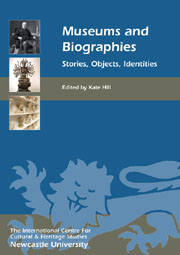Book contents
- Frontmatter
- Contents
- List of Illustrations
- Introduction: Museums and Biographies – Telling Stories about People, Things and Relationships
- INDIVIDUAL BIOGRAPHY AND MUSEUM HISTORY
- PROBLEMATISING INDIVIDUALS' BIOGRAPHIES
- INSTITUTIONAL BIOGRAPHIES
- 7 Significant Lives: Telling Stories of Museum Architecture
- 8 Schinkel's Museums: Collecting and Displaying Architecture in Berlin, 1844–1933
- 9 Personifying the Museum: Incorporation and Biography in American Museum History
- 10 Making an Exhibition of Ourselves
- 11 Institutional Autobiography and the Architecture of the Art Museum: Restoration and Remembering at the National Gallery in the 1980s
- OBJECT BIOGRAPHIES
- MUSEUMS AS BIOGRAPHY
- MUSEUMS AS AUTOBIOGRAPHY
- Endpiece: The Homunculus and the Pantograph, or Narcissus at the Met
- List of Contributors
- Index
9 - Personifying the Museum: Incorporation and Biography in American Museum History
from INSTITUTIONAL BIOGRAPHIES
Published online by Cambridge University Press: 05 February 2013
- Frontmatter
- Contents
- List of Illustrations
- Introduction: Museums and Biographies – Telling Stories about People, Things and Relationships
- INDIVIDUAL BIOGRAPHY AND MUSEUM HISTORY
- PROBLEMATISING INDIVIDUALS' BIOGRAPHIES
- INSTITUTIONAL BIOGRAPHIES
- 7 Significant Lives: Telling Stories of Museum Architecture
- 8 Schinkel's Museums: Collecting and Displaying Architecture in Berlin, 1844–1933
- 9 Personifying the Museum: Incorporation and Biography in American Museum History
- 10 Making an Exhibition of Ourselves
- 11 Institutional Autobiography and the Architecture of the Art Museum: Restoration and Remembering at the National Gallery in the 1980s
- OBJECT BIOGRAPHIES
- MUSEUMS AS BIOGRAPHY
- MUSEUMS AS AUTOBIOGRAPHY
- Endpiece: The Homunculus and the Pantograph, or Narcissus at the Met
- List of Contributors
- Index
Summary
The subtitle of Bayle St John's 1855 book The Louvre, or, Biography of a Museum, telegraphed the Englishman's humanisation of the museum's history and collections so that it would be ‘interesting even to readers who have never seen it’. Although he did not intend to treat the Louvre as a ‘personified institution’, St John hoped a biographical approach might prove more attractive to a potential readership (St John 1885, v–vi, 2). St John's use of ‘biography’ to characterise his approach was novel and followed by just a year the earliest deployment of the word for writings about subjects other than persons. By casting his discussion of the museum as though it were a biography, St John not only humanised his topic for potential readers but also made it easier to write about the Louvre as though its building wings, collections and curators were in fact an indivisible, living entity.
While St John's biographical approach was largely a rhetorical stratagem, his analogy resonated with an increasingly common phenomenon in England and America: the designation of enterprises composed of many people as ‘corporate’, that is, legally entitled to function as though single individuals. By the 19th century these ‘artificial persons’, formed to serve religious, educational, charitable, civil, or commercial purposes, were recognised with growing frequency through royal charters or legislative acts. In America, incorporation was the most common method for creating museums because the still comparatively young country, unlike those of Europe, had no history of royal or aristocratic collections that might be transformed – whether through revolution, as with the Louvre, or by donation, as with the Ashmolean – into public entities.
- Type
- Chapter
- Information
- Museums and BiographiesStories, Objects, Identities, pp. 133 - 144Publisher: Boydell & BrewerPrint publication year: 2012



